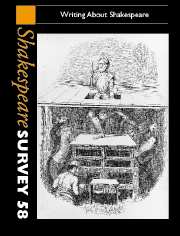Book contents
- Frontmatter
- Having Our Will: Imagination in Recent Shakespeare Biographies
- Toward a New Biography of Shakespeare
- Jonson, Shakespeare and the Exorcists
- ‘Lending soft audience to my sweet design’: Shifting Roles and Shifting Readings of Shakespeare’s ‘A Lover’s Complaint’
- ‘Armed at point exactly’: The Ghost in Hamlet
- Writing About Motive: Isabella, the Duke and Moral Authority
- Writing Performance: How to Elegize Elizabethan Actors
- Elizabeth Montagu: ‘Shakespear’s poor little Critick’?
- Rewriting Lear’s Untender Daughter: Fanny Price as a Regency Cordelia in Jane Austen’s Mansfield Park
- The Prequel as Palinode: Mary Cowden Clarke’s Girlhood of Shakespeare’s Heroines
- Shakespeare Among the Workers
- Virginia Woolf Reads Shakespeare: Or, her Silence on Master William
- Shakespeare and the Invention of the Epic Theatre: Working with Brecht
- Dramatizing the Dramatist
- Shakespeare in Drama Since 1990: Vanishing Act
- Writing about [Shakespearian] performance
- Shakespeare and the Prospect of Presentism
- Writing Shakespeare in the Global Economy
- The ‘Complexion’ of Twelfth Night
- Translation as Appropriation: Vassilis Rotas, Shakespeare and Modern Greek
- How Old Were Shakespeare’s Boy Actors?
- Mistress Tale Porter and the Triumph of Time: Slander and Old Wives’ Tales in The Winter’s Tale
- Shakespeare Performances in Ireland, 2002–2004
- Shakespeare Performances in England, 2004
- Professional Shakespeare Productions in the British Isles January–December 2003
- The Year's Contributions to Shakespearian Study 1 Critical Studies
- 2 Shakespeare in Performance
- 3 Editions and Textual Studies
- Books Received
- Index
The Prequel as Palinode: Mary Cowden Clarke’s Girlhood of Shakespeare’s Heroines
Published online by Cambridge University Press: 28 March 2007
- Frontmatter
- Having Our Will: Imagination in Recent Shakespeare Biographies
- Toward a New Biography of Shakespeare
- Jonson, Shakespeare and the Exorcists
- ‘Lending soft audience to my sweet design’: Shifting Roles and Shifting Readings of Shakespeare’s ‘A Lover’s Complaint’
- ‘Armed at point exactly’: The Ghost in Hamlet
- Writing About Motive: Isabella, the Duke and Moral Authority
- Writing Performance: How to Elegize Elizabethan Actors
- Elizabeth Montagu: ‘Shakespear’s poor little Critick’?
- Rewriting Lear’s Untender Daughter: Fanny Price as a Regency Cordelia in Jane Austen’s Mansfield Park
- The Prequel as Palinode: Mary Cowden Clarke’s Girlhood of Shakespeare’s Heroines
- Shakespeare Among the Workers
- Virginia Woolf Reads Shakespeare: Or, her Silence on Master William
- Shakespeare and the Invention of the Epic Theatre: Working with Brecht
- Dramatizing the Dramatist
- Shakespeare in Drama Since 1990: Vanishing Act
- Writing about [Shakespearian] performance
- Shakespeare and the Prospect of Presentism
- Writing Shakespeare in the Global Economy
- The ‘Complexion’ of Twelfth Night
- Translation as Appropriation: Vassilis Rotas, Shakespeare and Modern Greek
- How Old Were Shakespeare’s Boy Actors?
- Mistress Tale Porter and the Triumph of Time: Slander and Old Wives’ Tales in The Winter’s Tale
- Shakespeare Performances in Ireland, 2002–2004
- Shakespeare Performances in England, 2004
- Professional Shakespeare Productions in the British Isles January–December 2003
- The Year's Contributions to Shakespearian Study 1 Critical Studies
- 2 Shakespeare in Performance
- 3 Editions and Textual Studies
- Books Received
- Index
Summary
The principal task of the prequel is to return to the imagined origins of a well-known text’s events and characters. This curious exercise – an excavation of a text’s hypothetical history – might be compared with a Freudian case study: the present can only fully be understood with reference to a reconstituted past. The successful prequel, I would argue, is an essentially subversive form. A sequel can interest and surprise us without making us view the original in a different way, simply by introducing further characters and incidents, or by moving on to the next generation. A successful sequel can be an imitation or pastiche of the original, such as the sequels that have been written to many popular mainstream novels. But in a prequel, where the end of the story is already known, this freedom simply to expand is lacking, and some kind of disjuncture between the original and the new text is probably required. A prequel’s readers don’t want simply to be told what they know already; rather they want to be offered a new way into the old text. This desire in the reader for a twist or surprise is fully satisfied by Jane Smiley in A Thousand Acres (though, strictly speaking, this is an imaginative updating of King Lear with prequel elements rather than a pure prequel – much of the action corresponds to that of Shakespeare’s play itself). The key to this family’s dysfunctional dynamic lies in its incestuous secrets – Larry Cook abused his two elder daughters after his wife’s death, though not his youngest, Caroline. Although Smiley does not set out to prove in any crude way that King Lear itself is a play about incest, neither does she want us to see her interpretation as wild, anachronistic speculation. In an interview published by The Atlantic Online in 1998 she explains:
I’m not saying that Shakespeare ever thought of Lear as an incest perpetrator. I am saying that some people think there’s a kind of coded reference to incest in this group of folkloric stories, and that therefore you could plausibly attribute the older sisters’ deep, deep anger to abuse that they had undergone.
- Type
- Chapter
- Information
- Shakespeare Survey , pp. 95 - 106Publisher: Cambridge University PressPrint publication year: 2005
- 3
- Cited by

